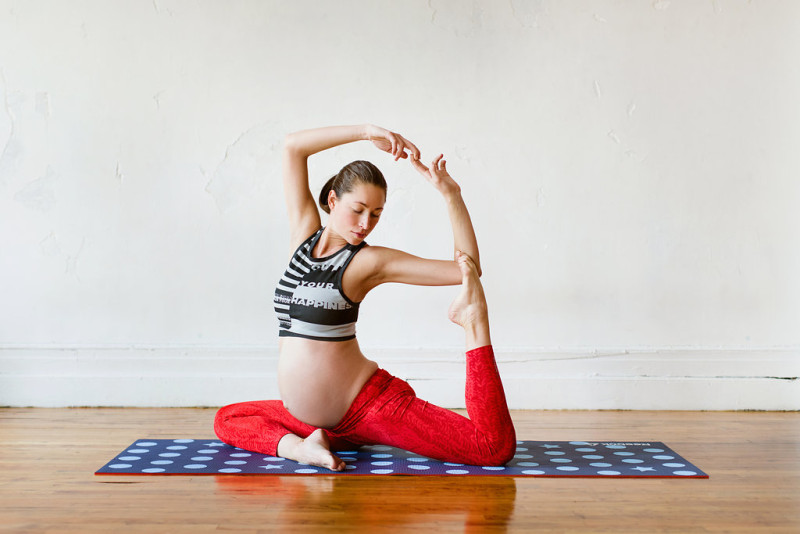
Why (And How) To Do Yoga While Pregnant
Written by Kristel Kovner Francesconi
Photography by Tara Stiles PHOTOGRAPHED BY HEATHER MOORE
Yoga is commonly recommended as a safe form of exercise for pregnant women, with many studios offering prenatal classes that cater to the needs of expectant mothers. However, like so much of what we do while pregnant, there is no shortage of opinions on exactly how we should do it. If you Google “yoga when pregnant” (which we do not recommend), you’ll likely be bombarded with mixed messages: Amidst many articles about the “don’ts” of prenatal yoga are plenty of photos of pregnant yogis in extreme backbends and headstands. As it turns out, misinformation about prenatal yoga (and pregnancy in general) is a pretty common problem. So, we went directly to a prenatal yoga expert for some clarity.
If you’ve ever been pregnant in the Bay Area, you have likely heard of Jane Austin. The trained midwife and doula has been teaching pre- and postnatal yoga for decades, and her packed-house classes (and popular online versions) have seen thousands of women through pregnancy and beyond. She is also the founder of Mama Tree, a prenatal yoga school dedicated to educating yoga teachers, doulas, and midwives on how to use the tools of yoga to support pregnant women and new moms in all stages of the childbearing years and beyond. She teaches the Yoga in Pregnancy component of many yoga teacher training schools and serves as the perinatal director of Yoga Tree in San Francisco. We had the chance to chat with Jane about her passion for working with pregnant women, her unique approach to prenatal yoga, and her advice for any yoga-curious mama-to-be.
How did you come to teach prenatal yoga?
“I moved to San Francisco in 1989, and I dabbled in yoga here and there, but it really wasn’t until I got pregnant with my first child that I tapped into something much deeper with my yoga practice. Even though I loved the way yoga made me feel, I couldn’t find a prenatal class that met my specific needs, and that’s when the seed was planted: I wanted to start teaching yoga. I’m also trained as a midwife and doula, so I married my two passions of working with women and yoga. It’s through those two lineages that I built Mama Tree, where I train teachers to work with pregnant women. It’s based in a holistic perspective about women’s health, using the ancient tools of yoga to support a woman in one of the most profound changes in her life.”
What did you feel was missing in the prenatal classes you tried?
“There is a misconception that prenatal yoga is gentle. Motherhood is not gentle, so preparing for it shouldn’t be. Of course, there’s a gentle component to prenatal yoga, involving kindness and compassion. But I wanted practices that were designed to build strength in the lower and upper body, while inviting women to soften and open; prenatal yoga as a combination of strength building and developing stamina.”
What is your general philosophy when it comes to teaching yoga to expectant mothers?
“The whole purpose of yoga and its function, pregnant or not, is to reduce suffering. The cool thing about yoga is that it can meet you where you are. I would say, have a practice that allows you to be present, be kind to yourself, to sit with yourself as you are. Let it be an opportunity to let go of judgement or distrust, all the stuff that we get bombarded with as women culturally, as well as that internal dialog we tell ourselves.”
How early on into pregnancy do you recommend an expectant mother start prenatal yoga?
“Prenatal yoga is appropriate all through the pregnancy. Sometimes women aren’t feeling well enough to do yoga in the first trimester, so it’s common for women to wait until the second trimester to return to their yoga practice or begin a prenatal practice.”
How late into pregnancy can she practice?
“All the way until she gives birth! I work with about 200 women a week and I’ve had multiple bags of water release in my class. It’s funny because it’s usually one spot in the room, and it’s like ‘the magic spot.’ But it’s really close to the door, which is close to the bathroom, so when a woman is that pregnant, she’ll often sit there because she knows she will have to pee multiple times during class. So, in this one spot in the room…7, 8, 9 or 10 bags of water have broken in that area.”
There’s so much information about what you can and can’t do when pregnant. What is your approach to this in your classes?
“It’s really confusing when you get pregnant because there are a lot of opinions out there, and people love to tell pregnant women their opinions. Periodically, a woman who is not visibly pregnant will come up to me and say ‘I’m pregnant and I’m just wondering what I shouldn’t do in yoga?’ And that’s what everyone asks. I just turn it back to her and say, ‘What feels good to you right now?’ so she can begin to inquire within about what is appropriate for her. If a woman is listening to her body and responding to her needs, she will make healthy choices about what’s good for her and her baby. Unfortunately, ego often drives the practice, and that’s what causes injury. It’s about giving women the opportunity to do that self-reflection.”
Are there any “don’ts” in your prenatal classes?
“There are certainly guidelines for prenatal yoga. A woman who is pregnant has hormones that make her more mobile in her joints, and therefore more susceptible to injury if she’s not cautious around some of the deeper postures. I do think it’s prudent for pregnant women not to take their body into extreme shapes. I wouldn’t recommend that a pregnant woman put a foot behind her head, for example. And she may be able to do that, but my question is always ‘What is the benefit of that pose?’ When you look at a pregnant woman’s body, the front is lengthening and the back is shortening, which is technically a backbend. So, what would be the benefit of going into a backbend? In terms of someone who is really flexible, I would recommend she go 80% of her flexibility during pregnancy; a practice that will give her the opening without causing instability. There should also be caution with supine postures. Pregnant women should avoid lying on their back for too long because this can compress the vena cava. In a prenatal class, I don’t do anything on the back. And, it’s important for pregnant women to avoid getting overheated and dehydrated during class. I recommend making sure she is hydrated before practice and if she needs to drink water during her practice, that’s fine. Also, she should eat a little bit before practice, so her blood sugar doesn’t drop.”
Is it true that a pregnant woman shouldn’t do twists?
“I hate when pregnant women are told they shouldn’t twist. A twist is a normal function of the spine! But certainly, a pregnant woman should do an open twist, so she’s also moving the pelvis when she twists instead of locking the pelvis down.”
As a doula, how do you use yoga in the delivery room?
“Yoga is empowering for women in preparation for birth in terms of body awareness and confidence. During labor, we practice postures that open up the hips, and get into hands and knees. It’s really common for women to labor on hands and knees, because it actually gets the baby off their back. However, we don’t see this in our culture—what we see is a woman being wheeled off on a gurney screaming ‘You did this to me!’ at her partner; I’ve been to hundreds of births and I’ve never seen a woman do that. So, we have this perception of what birth looks like. If a woman is choosing her own birth position, rarely does she choose to lie on her back. They are directed to go into that position. When I do home birth, women birth their babies in all different positions. As a result, the midwife is often on their hands and knees. I think if people actually saw how women labor in an undisturbed way, we would be way less freaked out by it. The natural rhythms of labor are not as terrifying as they are depicted in the media and what we consume. I think we know a lot intuitively, and if we pay attention, women can make appropriate choices for themselves and their baby.”
Any advice for expectant mothers interested in starting prenatal yoga?
“If a woman doesn’t find a class that really resonates with her, I would encourage her to keep looking! There are really good teachers out there, but not every teacher is going to fit every woman’s particular style. Try more classes, because the community you get in a prenatal class is really invaluable. Go find a class that works for you so that you can connect with other mamas.”
For more on jumpstarting a yoga practice, check out these 10 Easy Yoga Poses for Pregnancy, our Pregnancy Style Profile on Superstar Yogi Tara Stiles, and 15 Great Yoga Poses for Kids.
Share this story



